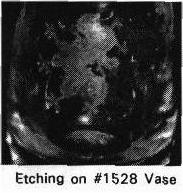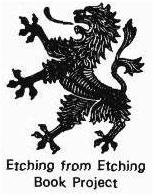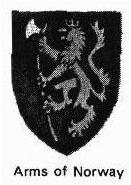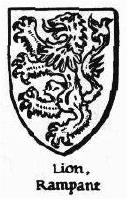The Regal Lion
by Dave Rankin
Issue No. 245 - September 1993
Many interesting items can be seen during the events at an NCC Convention: at the Show and Sale, the Show and Tell program, and during other programs. One such item appeared during the Former Workers' Reunion. One worker brought a #1528 vase (vase pictured below with "Star" cutting) in Mandarin Gold with an unusual etching. Being involved in the Miami Valley (Ohio) Study Group's etching book project, several of us studied the piece with much interest.

| 
| 
| 
|
It had been suggested that this is the Lion etching. The Lion
etching has not been seen in any catalog. The only reference seen so
 far was in a Cambridge price list dated October 1, 1956 on a #l528
vase. It seemed ike a possible match but it did not look much like a
lion. How did they come up with that name?
far was in a Cambridge price list dated October 1, 1956 on a #l528
vase. It seemed ike a possible match but it did not look much like a
lion. How did they come up with that name?
After careful examination of the grotesque little figure, it was suggested that it was a Griffin, not a Lion. Was this really the Lion etching? What is a Griffin? The questions remained unanswered until I got home from the Convention. Buoyed by a recent success on Mah-Jongg tiles, I reached for the Encyclopaedia Britannica:
Griffin (Griffon, Gryphon) a composite creature with lion body. winged or wingless, and bird (usually eagle) head.
Our little figure had no wings, no bird head. After excursions into articles on Greek art, Pre-Hellenic architecture, and jewelry, I gave up looking for a picture of a griffin that matched our etching sample.
An article on Heraldry finally ended the search. One sentence summed it up. "The regality which is supposed to reside in the Leo of astrology, prominent in all ancient lore, must have been a powerful inducement to monarchs to assume the lion as a device." The article illustrated 14 color examples of royal arms in the first two pages, nine of them used the lion in one form or another. The arms of Philip I of Flanders, 1164, was the earliest example shown. What a remarkable similarity to the etching on the #1528 vase. Five other arms also used the Lion in substantially the same shape. I can no longer doubt that this is the Lion etching.
This story is a long way from being complete. The 1956 price list also references two gold decorates, Star (shown at right) and Moon, and two other unidentified etchings. The etching book project is again seeking your assistance in identifying these two etchings. If you have an etching on the #1528 vase, other than those discussed here, please send a rubbing and/or picture to the Miami Valley Study Group.
